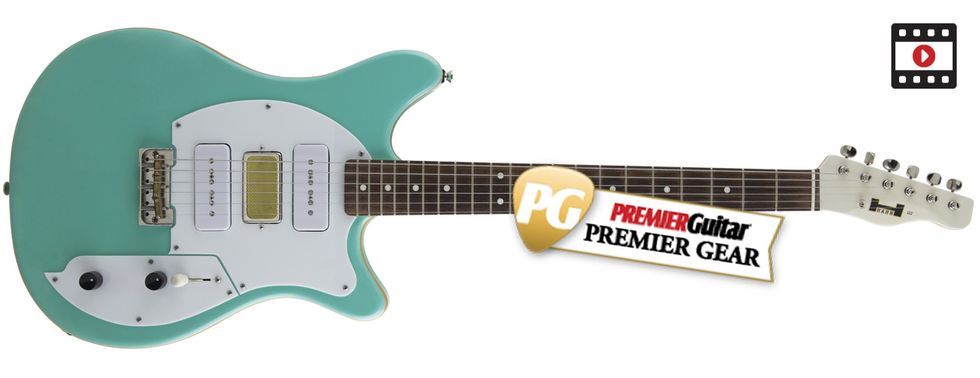If this guitar were getting married and you were an usher, you might have trouble seating the guests appropriately. Yeah, you could put the Telecaster relatives on one side of the aisle and the Stratocaster kin on the other, but then where would you seat the Gibson cousins?
The 112 model from Hahn Guitars is a Tele/Strat mash-up. Except it has P-90s. Plus a gold-foil pickup, because why the hell not? That might sound like a 6-string platypus with identity issues. But the 112 is a superb instrument whose unconventional parts conspire to produce lovely and unique tones. (Luthier Chihoe Hahn reportedly developed the model in tandem with the late Walter Becker.)
Mr. In-Between
Fender fans will instantly feel comfortable with the 112’s neck, body, and wiring scheme. Meanwhile, the unconventional pickup choices yield far-from-Fender tones that will probably delight single-coil fans who find Stratocasters a bit thin and prickly, as well as Stratocaster/Telecaster lovers seeking fresh variations on those iconic sounds.
The double-cutaway alder body is handsome, with horns more rounded and shortened than a Stratocaster’s. There are S-style forearm and belly bevels. The solid sea-foam green finish and two-piece, single-ply pickguard have an easy, utilitarian vibe. Meanwhile, the pretty strip of unpainted wood that rings the body’s perimeter adds understated bling.
just another Whatevercaster.
The 112 uses a 25 1/2"-scale, and a 21-fret rosewood fretboard caps the bolt-on maple neck. The neck’s palm-filling D-shape has vintage-style heft. The headstock has a modified T-style shape, with an ornamental bevel that echoes the one on the body’s upper bout. The tuners are Kluson-style Gotohs. The T-style bridge has three brass saddles, and it permits either top-load or through-body stringing. (I reviewed and recorded the guitar with the strings running through the body.)
The 112’s workmanship is … pretty much perfect. The body and headstock finishes could make a mirror feel insecure. The medium-jumbo frets are masterfully installed, their ends sensually rounded. The neck joint could scarcely be tighter. The guitar arrived perfectly set up (and perfectly tuned, no less) in the included Mono gig bag.
Foiled Again?
Rob Banta, Hahn’s in-house winder, created the three pickups. They’re configured via a 5-way selector switch—your classic Stratocaster recipe. Despite their retro appearance, the pickups aren’t strictly vintage. The bridge pickup, a bright yet full-bodied P-90, comes closest to a traditional design. The neck P-90 looks similar, but uses individual rod magnets in lieu of the usual bar magnet, yielding slightly cleaner and brighter tones reminiscent of a Jazzmaster pickup.
“Gold-foil” can refer to several vintage pickup models and their modern replicas. For many, the first gold-foils that spring to mind are the rubber-magnet pickups from 1960s Teisco guitars. Most of today’s gold-foil reissues employ similar rubberized magnets. (That includes the Lollar and Mojotone versions, as well the Roadhouse pickups used in recent Supro guitars.) Hahn opts instead for NOS ceramic magnets, which generate louder, brighter tones.
Ratings
Pros:
Superb materials and workmanship. Fine, fresh-sounding tones from an unusual pickup array. Supremely comfortable.
Cons:
None.
Tones:
Playability:
Build/Design:
Value:
Street:
$1,950
Hahn Guitars 112
hahnguitars.com
The Hahn/Banta gold-foil doesn’t have the idiosyncratic “acoustic-guitar-like” resonance of a rubber-magnet gold-foil, but it’s a fine-sounding single-coil that blends seamlessly with the custom P-90s. Also, avoiding rubber magnets sidesteps a quirk of Teisco-style pickups: Their tones tend to crap out rather than clean up when you roll back your guitar’s volume pot. Like the P-90s, Hahn’s gold-foil has wide dynamic range and gratifying touch response.
Cunning Coils
Unplugged, the 112 has the airy zing of a fine old alder-bodied Fender. Each pickup sounds lovely on its own and with its neighbor. (Hmm … makes me think about a neck-plus-bridge wiring mod. I bet the P-90s would sound awesome together.) The tonal relationships between pickups are roughly Strat-like, with fat neck tones, penetrating bridge tones, and attractively “hollow” sounds in the combined positions.
But the core timbres aren’t so Stratocaster-like. Compared to traditional S-style pickups, these carry more low midrange poundage. They distort more readily at lower levels. The quality of distortion differs, too. There’s more harmonic breakup of the upper mids, yielding a uniquely chiming yet “furry” jangle. There’s explosive treble energy: Notes and chords tend to land with a tough, authoritative clang. But overall, highs are more diffuse and less “icepicky” than on a traditional Strat.
Players sometime describe P-90s as more “rough sounding” than Fender-style single-coils, but there’s nothing lo-fi about the 112’s voice. Note fundamentals have etched-in-stone clarity. There’s excellent string-to-string separation. The range of tones is absurdly versatile. You can veer from rock wankage to suave jazz to punky chunk with uniformly fine results.
The Verdict
Today there’s no shortage of Fender-flavored guitars that swap in unexpected parts, à la Mr. Potato Head. But Hahn’s 112 isn’t just another Whatevercaster.It’s a superbly made instrument with a unique yet versatile voice. Fender fans will feel right at home. So will players who dig single-coils but sometimes wince at those extra-crispy Strat squawks. The $1,895 price is formidable, but fair for a handcrafted U.S. solidbody with largely custom hardware. (Two-pickup models sell for $100 less.) The 112 is an inspiring instrument with a voice of its own.
Watch the Review Demo:





























